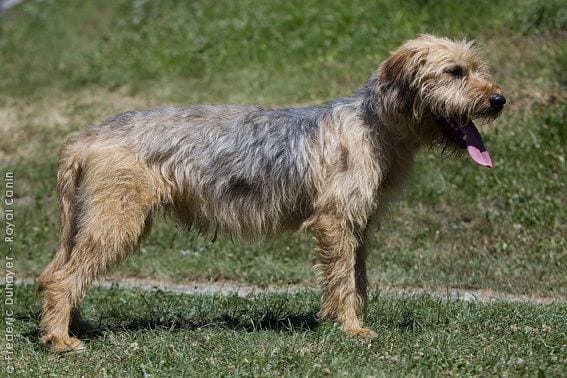About Bosnian Coarse Haired Hound
Height 18-22 inches
Weight 35-55 lb
Lifespan 12-15 years
Group UKC Scenthound
Best Suited For active families, active singles, house with a yard, experienced dog owners
Temperament intelligent, obedient, friendly, gentle
Comparable Breed Istrian Shorthaired Hound, Istrian Coarse-haired Hound

The Bosnian Coarse Haired Hound, also known as the Bosanski Ostrodlaki Gonic or the Barak, is a hunting breed that was developed in Bosnia.
For having a shaggy coat and having been developed as a scent hound, is used to hunt large animals. If you’re looking for something unique and aren’t afraid to look outside of the United States for it, might be worth your attention.
The Bosnian Coarse-Haired Hound, also known as the Bosanski Ostrodlaki Gonic or the Barak, is a hunting breed that was developed in Bosnia.
Origin
The Illyrian Hound was the previous name for the Bosnian Coarse Haired Hound, which was named after the area’s pre-Slavic natives. The current breed was created in the 1890s when Italian gundogs and other native dog breeds were bred together.
The Bosnian Coarse Haired Hound was bred to be slightly smaller than other hounds of the time, but nevertheless to be an efficient scent hound. It is likely that the Istrian Shorthaired Hound played a role in its development because of this.
The FCI first recognized the Bosnian Coarse-Haired Hound, also known as the Barak by the UKC, in 1965 under the name “Illyrian Hound.” Because the AKC has not yet recognized it, it is still a rare breed and a unique family pet.
Pedigree
The Bosnian Coarse Haired Hound was created in the 1890s when various indigenous dog breeds and Italian gundogs interbred.
Food/Diet
Given that it is a medium- to large-sized breed, the Bosnian Coarse Haired Hound should be fed a premium dry food meant for adult dogs. He would do better on an active or working breed formula, though, given that the breed is primarily used as a working breed, providing that you take care to avoid overfeeding in order to prevent obesity.

Due to his hunting heritage, the Bosnian Coarse Haired Hound is frequently a trainable breed.
Training
Being primarily bred for hunting, the Bosnian Coarse Haired Hound is frequently a versatile and trainable breed. Training and exercise should be integrated for them because of their high level of energy and passion for their jobs.
The Bosnian Coarse Haired Hound can work hard for extended periods of time in difficult terrain, so a brief daily walk won’t be sufficient to meet his exercise needs. These dogs run a high risk of developing undesired tendencies, such as excessive barking and destructiveness, when they don’t get enough exercise.
Weight
The Bosnian Coarse Haired Hound is a medium- to large-sized dog, growing to a mature weight of 35 to 55 pounds and a height of 18 to 22 inches.
Temperament/Behavior
The Bosnian Coarse Haired Hound is still a very unusual breed outside of its home country, where it is most usually utilized as a working breed. As a result, nothing is known about the breed’s behavior in a home environment.
Bosnian Coarse Haired Hound are often a friendly and affectionate breed that gets along with children and can occasionally be raised with smaller animals like cats. It takes a lot of training and socialization to get along with strangers and occasionally other dogs because the breed is particularly committed to its profession and to its owner.
The breed tends to be noisier and more vocal than other dogs, so even while these qualities can be reduced via training, they generally won’t be entirely eliminated.
Common Health Problems
Although there isn’t much information on the Bosnian Coarse Haired Hound’s health, the breed is often in good health. However, some problems are common to all canine species. Several disorders have been associated with this breed, including hip dysplasia, elbow dysplasia, cataracts, progressive retinal atrophy, patellar luxation, and entropion.
anticipated life span
According to estimates, the Bosnian Coarse Haired Hound lives an average lifespan of 12 to 15 years, which is about average for a breed of its size.
exercise guidelines
Being a hunting breed, the Bosnian Coarse Haired Hound has high exercise requirements; just one daily walk is insufficient for this species. These dogs were raised to work for extended periods of time on difficult terrain, which gives them a strong work ethic and exceptional endurance. This breed will benefit from having a fenced-in yard to run around in because they need at least 45 minutes of vigorous activity each day.
The Bosnian Coarse Haired Hound is a gregarious and loving breed.

AKC
The Bosnian Coarse Haired Hound is presently recognized by the FCI and the UKC, but not by the AKC. He is categorized as a Group 6 Scenthound by the FCI and the UKC.
Coat
It is clear from the breed name that the Bosnian Coarse Haired Hound has a medium-length coarse coat. The breed has a double coat that is made up of a long, tousled-appearing outer coat and a short, dense undercoat. He has thick eyebrows, a mustache and beard that are both short but prominent, and some of the hair on his face has grown longer. The most popular variations include a solid coat, a solid with white markings, or a tricolor coat using different shades of wheaten yellow, earthy grey, reddish yellow, or black.
Puppies
Three to seven puppies per litter are usual for the Bosnian Coarse Haired Hound breed. This breed matures at over 50 pounds, so puppies need be given a large-breed puppy formula. Once they have reached 80% of their expected maximum growth, you can switch to a large-breed adult formula. As soon as you can, you should also start socializing and training your puppy.
More information about Dog Breeds & Dog Care follow Dog Care Tips site.

